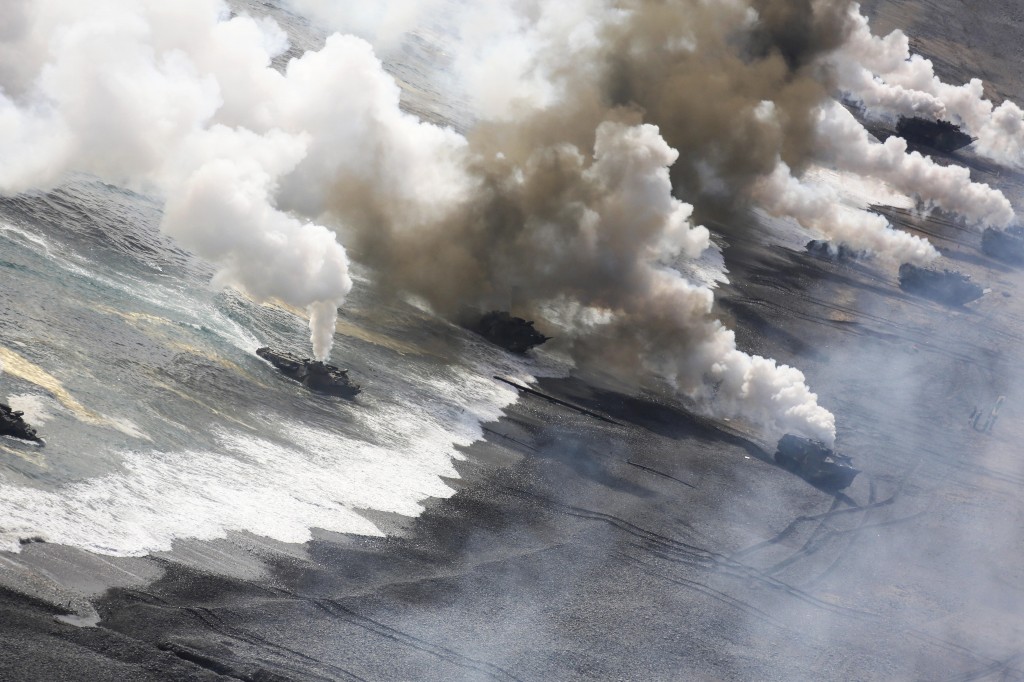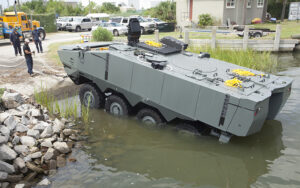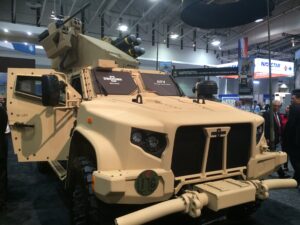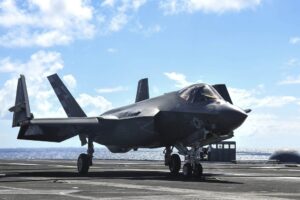
US and Korean Marines staged traditional amphibious assaults like this in the Ssang Yong 2014 wargames — but such massed attacks may be a thing of the past.
WASHINGTON: The Senate Armed Services Committee has proposed the most sweeping reevaluation of the military in 30 years, with tough questions for all four armed services but especially the Marine Corps.
While its provisions cover topics ranging from swarming robots to “construction and maintenance of public works in Cis-Lunar Space,” its overwhelming focus is reorienting the military from a generation of guerrilla warfare to great power conflict with China and Russia. From reading Section 1041 of the draft National Defense Authorization Act, talking to Senate staff, and tracking years of SASC reform proposals, it’s clear SASC chairman John McCain thinks the services are making that shift far too slowly. McCain has long sought to revisit the landmark 1986 Goldwater-Nichols Act which laid the foundation for the modern military, and now he may have found an ally in Defense Secretary Jim Mattis.
The first lines of Sec. 1041 take pains to praise Mattis’s National Defense Strategy, which marks “great power competition” against China and Russia as the top priority. The rest of the section charges Mattis with preparing a report — due in classified form with an unclassified summary by Feb. 1st — on making the four armed services more capable against those threats.
Today, SASC argues, the services are spending too much of their money on weapons systems that would work against the Taliban but might not last long against a high-tech adversary. That includes everything from manned aircraft — even stealthy ones — to lightly armored ground vehicles to pretty much everything the Marine Corps would use for an amphibious landing.
Here are some of the key questions the Pentagon would be required to address:
Make the Marines a counterinsurgency force? The Senate starts by asking whether the military “would benefit from having one Armed Force dedicated primarily to low-intensity missions, thereby enabling the other Armed Forces to focus more exclusively on advanced peer competitors.” It quickly becomes clear that “one Armed Force” means “the Marines.” The bill questions the Army’s new Security Force Assistance Brigades (SFABs) and suggest shifting that role to the Marines. It also questions the survivability of Navy-Marine flotillas in the face of long-range sensors and precision missiles — so-called Anti-Access/Area Denial (A2/AD) systems — and asked whether the Marines’ core mission, “amphibious forced entry operations,” should even “remain an enduring mission for the joint force” given the difficulties. It suggests replacing large-deck amphibious ships, which carry both Marine aircraft and landing forces, with small aircraft carriers that could carry “larger numbers of more diverse strike aircraft” (but not amphibious vehicles or landing craft). Separate provisions of the bill restrict spending on the current Amphibious Assault Vehicle (Sec. 221) and the future Amphibious Combat Vehicle (Sec. 128) until the Pentagon addresses the viability of amphibious landings.
Make the Army heavier, with fewer helicopters? The report must include “a revalidation” of ground modernization efforts that SASC sees as too vulnerable in great power combat. It calls out three programs by name: the Joint Light Tactical Vehicle (JLTV), a better-protected replacement for the Humvee co-developed with the Marine Corps; the Mobile Protected Firepower (MPF) vehicle, an Army-only program for, essentially, a light tank to support light infantry; and Future Vertical Lift (FVL), intended to replace all the services’ helicopters with more advanced “optionally manned” aircraft. A separate section (Sec. 236) requires a separate report specifically on the survivability and offensive value of MPF and FVL.
By contrast, the report repeatedly emphasizes the value of drones and robotics, with the clear implication that, given the increasing lethality of anti-aircraft systems, why not instead move to entirely unmanned aircraft that never put a human crew at risk? SASC staff made clear they think the Army is over-invested in helicopters and light infantry, both highly relevant to counterinsurgency but dangerously fragile in a major war. The bill urges the Army to look hard at its mix of forces, not neglecting armor, mechanized infantry, artillery, and air defense; a separate section (Sec. 111) authorizes up to $500 million to speed up defense against cruise missile threats. Another provision (Sec. 1254) requires a report on stationing an Army brigade permanently in Poland.
Refocus Special Operations against Russia and China? Special Operations have historically led the way on advising and assisting foreign forces, with the regular Army only getting in the advisor business because of the sheer scale of need in Iraq and Afghanistan. The SASC language suggests special operators are now overstretched and might transfer many of their global missions to conventional forces (perhaps to the Marines) so they can focus their efforts on the “pacing threats and priority missions of the National Defense Strategy.” That presumably means Russia and China. While pitting small bands of commandos directly against tank regiments and long-range missiles is a losing battle, special ops played a major role in Cold War Europe preparing for partisan warfare against a Soviet invasion, and they could play a similar role today in places like the Baltic States or the Philippines.
Rely less on stealth aircraft and more on drones? SASC asks skeptically whether stealth aircraft — specifically calling out the new F-35 fighter, the in-development B-21 bomber, and the proposed Penetrating Counter-Air platform — will be able to survive against increasingly advanced air defenses. It suggests that, at least in some cases, non-stealthy aircraft with upgraded weapons and sensors could do the job as well. It repeatedly lauds the increasing potential of cheap robotics for missions from reconnaissance to combat to supply — not only in the air but “on and under the sea, on land, and in space.”
Another passage suggests the Navy should develop “longer-range, unmanned, carrier-suitable strike aircraft,” a revival of the UCLASS drone program that the Navy abandoned in 2016. Besides replacing manned aircraft with robotic ones, SASC also suggests that missions now performed by airplanes could be handled by satellites, such as surveillance or battle management, or by ships and ground units, such as shooting down enemy planes with anti-aircraft missiles instead of our own fighters.
There are plenty of other provisions that might impact the Air Force: a “revalidation” of whether the Air Force’s new KC-46 tankers are too vulnerable to attack; an assessment of whether another service (maybe the Marines…) should also buy the propeller-driven Light Attack Aircraft the Air Force is exploring for counterinsurgency [UPDATE: the full bill adds $100 million to the budget to buy an “O/A-X” light attack plane for the Marines]; and a host of space provisions urging more cooperation with private companies. By contrast, the Navy gets off fairly lightly, with the significant exception of its air wing and its amphibious ships. The biggest challenge here is for the ground services, the Army and Marines — and above all the Marines.
The full text of Section 1041 follows, reformatted for readability.
In a ‘world first,’ DARPA project demonstrates AI dogfighting in real jet
“The potential for machine learning in aviation, whether military or civil, is enormous,” said Air Force Col. James Valpiani. “And these fundamental questions of how do we do it, how do we do it safely, how do we train them, are the questions that we are trying to get after.”































